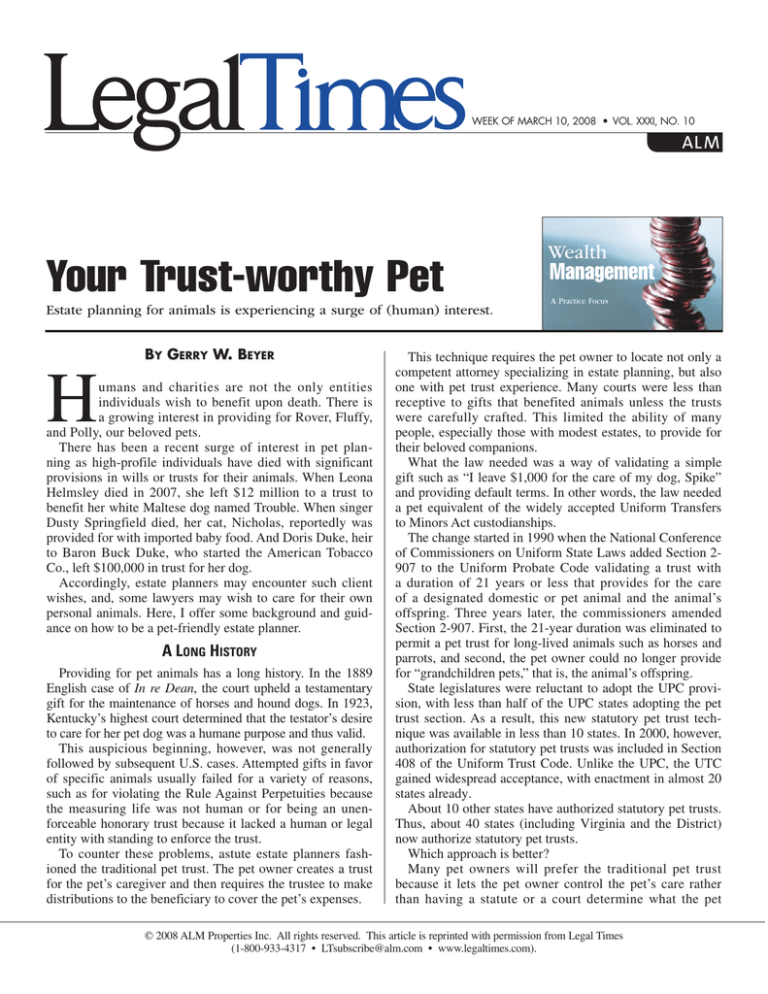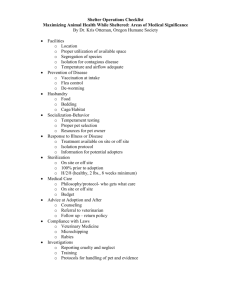
WEEK OF march 10, 2008 • VOL. XXXI, NO. 10
Your Trust-worthy Pet
Estate planning for animals is experiencing a surge of (human) interest.
H
By Gerry W. Beyer
umans and charities are not the only entities
individuals wish to benefit upon death. There is
a growing interest in providing for Rover, Fluffy,
and Polly, our beloved pets.
There has been a recent surge of interest in pet planning as high-profile individuals have died with significant
provisions in wills or trusts for their animals. When Leona
Helmsley died in 2007, she left $12 million to a trust to
benefit her white Maltese dog named Trouble. When singer
Dusty Springfield died, her cat, Nicholas, reportedly was
provided for with imported baby food. And Doris Duke, heir
to Baron Buck Duke, who started the American Tobacco
Co., left $100,000 in trust for her dog.
Accordingly, estate planners may encounter such client
wishes, and, some lawyers may wish to care for their own
personal animals. Here, I offer some background and guidance on how to be a pet-friendly estate planner.
A Long History
Providing for pet animals has a long history. In the 1889
English case of In re Dean, the court upheld a testamentary
gift for the maintenance of horses and hound dogs. In 1923,
Kentucky’s highest court determined that the testator’s desire
to care for her pet dog was a humane purpose and thus valid.
This auspicious beginning, however, was not generally
followed by subsequent U.S. cases. Attempted gifts in favor
of specific animals usually failed for a variety of reasons,
such as for violating the Rule Against Perpetuities because
the measuring life was not human or for being an unenforceable honorary trust because it lacked a human or legal
entity with standing to enforce the trust.
To counter these problems, astute estate planners fashioned the traditional pet trust. The pet owner creates a trust
for the pet’s caregiver and then requires the trustee to make
distributions to the beneficiary to cover the pet’s expenses.
Wealth
Management
A Practice Focus
This technique requires the pet owner to locate not only a
competent attorney specializing in estate planning, but also
one with pet trust experience. Many courts were less than
receptive to gifts that benefited animals unless the trusts
were carefully crafted. This limited the ability of many
people, especially those with modest estates, to provide for
their beloved companions.
What the law needed was a way of validating a simple
gift such as “I leave $1,000 for the care of my dog, Spike”
and providing default terms. In other words, the law needed
a pet equivalent of the widely accepted Uniform Transfers
to Minors Act custodianships.
The change started in 1990 when the National Conference
of Commissioners on Uniform State Laws added Section 2907 to the Uniform Probate Code validating a trust with
a duration of 21 years or less that provides for the care
of a designated domestic or pet animal and the animal’s
offspring. Three years later, the commissioners amended
Section 2-907. First, the 21-year duration was eliminated to
permit a pet trust for long-lived animals such as horses and
parrots, and second, the pet owner could no longer provide
for “grandchildren pets,” that is, the animal’s offspring.
State legislatures were reluctant to adopt the UPC provision, with less than half of the UPC states adopting the pet
trust section. As a result, this new statutory pet trust technique was available in less than 10 states. In 2000, however,
authorization for statutory pet trusts was included in Section
408 of the Uniform Trust Code. Unlike the UPC, the UTC
gained widespread acceptance, with enactment in almost 20
states already.
About 10 other states have authorized statutory pet trusts.
Thus, about 40 states (including Virginia and the District)
now authorize statutory pet trusts.
Which approach is better?
Many pet owners will prefer the traditional pet trust
because it lets the pet owner control the pet’s care rather
than having a statute or a court determine what the pet
© 2008 ALM Properties Inc. All rights reserved. This article is reprinted with permission from Legal Times
(1-800-933-4317 • LTsubscribe@alm.com • www.legaltimes.com).
needs. The owner may specify who manages the property
(the trustee), the pet’s caregiver (the beneficiary), what type
of expenses relating to the pet the trustee will pay, the type
of care the animal will receive, what happens if the beneficiary can no longer care for the animal, and the disposition
of the pet after the pet dies.
If the client, however, has a modest estate or is not interested in supplying such details, a statutory pet trust provides a quick, economical, and easy method to carry out
the pet owner’s intent. This assumes, of course, that the
client establishes the trust in one of the jurisdictions with
pet trust legislation.
Key Considerations
For traditional pet trusts, there are 13 important things
to consider:
1. Create the trust inter vivos or in the pet owner’s will?
An inter vivos trust takes effect immediately, thus avoiding a
gap in having funds available for the pet’s care. Despite this
significant benefit, most pet trusts are testamentary because
of the reduced start-up costs and lack of administration
expenses when the pet owner dies.
2. Who is the animal’s caregiver (the beneficiary of the
trust)? This is the most important decision because this
person will provide the pet’s care. The pet, the prospective
caregiver, and the caregiver’s family (human and nonhuman) should make sure they get along. It is important to
name alternates in case the designated person is unable
to care for the pet. The trustee may be given the ability to
select a good home for the pet if none of the named beneficiaries can care for the animal. But the trustee must not be
permitted to appoint him- or herself, as this would eliminate
the checks-and-balances aspect of separating the caregiver
from the money provider.
3. Who is the trustee and will the trustee be paid? The
responsibilities of trustees of pet trusts may be different
from those of other trusts, and thus it is important to be sure
they are willing to take on the job. If the pet owner has sufficient funds, consider a stipend for the trustee. If the trust is
relatively large, consider a corporate trustee.
4. When should ownership of the pet be transferred?
Because animals are property, the pet needs to be formally
transferred to the trust. If the trust is inter vivos, this may
occur immediately or upon death. If the trust is testamentary, a specific gift of the animal to the trustee, in trust, is
required, with instructions to deliver the pet to the caregiver.
5. What and how much property should be transferred to
the trust? The pet owner needs to determine the money or
other assets that will be needed for the pet’s care, additional
distributions to the caregiver, the trustee’s fee, and other
expenses. Factors include the type of animal, the animal’s
life expectancy (hamsters live just a few years while parrots
can hit the century mark), the animal’s standard of living,
and the potential for expensive medical care. Some trusts
are designed to “use up” the corpus while providing for the
pet, and other trusts, especially those for long-lived animals,
function as an “endowment” where the pet’s expenses come
from income. The pet owner should not transfer an unreasonably large amount of property, lest it encourage other
estate beneficiaries to contest the transfer.
6. What is the desired standard of living for the pet? The
pet owner should describe the type of care for the animal. In
one famous case, the court decided that a dog did not need a
new car for the caregiver to give the dog rides to rural areas
and to purchase dog food.
7. How is the distribution of trust property to the caregiver determined? There are three common methods. First,
the trustee pays the caregiver a fixed sum each month. This
makes it easy to administer the trust but does not address
extraordinary care. Second, the trustee pays a fixed sum
but has discretion to make additional distributions if the
caregiver incurs extraordinary expenses. The third method
is a pure reimbursement approach in which the trustee reimburses caregiver receipts if appropriate.
8. Should the caregiver be “paid” for services? One pet
owner may believe that giving a cost-free pet to the caregiver enhances the caregiver’s life and that alone should
be sufficient reward, but another pet owner may think that
someone who is paid may do a better job.
9. When should the trust end? Unless local law has modified the Rule Against Perpetuities, it is important not to link
the duration of the trust to the life of the pet. Instead, the
trust should end upon a fixed date (the longest allowed) or
upon the animal’s death.
10. Who should be the remainder beneficiary when the
trust ends? Most pet trusts provide that the remainder passes to a charity that benefits the type of animal in the trust.
Under no circumstances, how­ever, should the pet owner
leave the remainder to the caregiver because the caregiver
would then have a disincentive to keep the animal alive.
11. How should the animal be identified? The pet owner
or the trustee must take steps to identify the animal (e.g., a
detailed written description, photos, implanted microchip, or
DNA preservation) to prevent fraud by a caregiver who does
not want to lose benefits when the animal dies. There is one
case where a caregiver was on her third black cat before the
ruse was discovered.
12. How should the animal’s welfare be monitored? The
caregiver should instruct the trustee to conduct random
inspections of the pet in the caregiver’s home to assess the
pet’s well-being.
13. What happens to the pet when it dies? The pet owner
should provide instructions for disposing of the pet such as
burial in the backyard, a pet cemetery, or a cremation.
Pet animals have a much better track record than some
humans in providing unconditional love and steadfast loyalty. It is not surprising that a pet owner often wants his or her
trusted companion to be well-cared for, and sound planning
with pet trusts can help this occur.
Gerry W. Beyer is the Governor Preston E. Smith Regents
professor of law at the Texas Tech University School of Law in
Lubbock, Texas. He writes and lectures extensively on estate
planning and can be contacted at gwb@professorbeyer.com.
© 2008 ALM Properties Inc. All rights reserved. This article is reprinted with permission from Legal Times
(1-800-933-4317 • LTsubscribe@alm.com • www.legaltimes.com).







